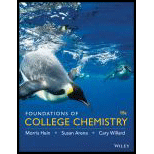
Concept explainers
(a)
Interpretation:
Concept Introduction:
Alpha particle
General equation for alpha decay is as follows:
Here,
Beta emission
The generic equation of the beta decay is as follows:
Here,
Gamma rays
(a)
Explanation of Solution
Skeleton equation for transition is as follows:
Since this transition is nuclear fission between
Sum of mass number on left side is 31 and on right side is 30. Thus missed particle must have 1 mass number.
Sum of atomic number on left side is 15 and on right side is 15. Thus missed particle must have 1 atomic number.
Atomic particle with 1 mass number and zero atomic number is
Hence resultant nuclear equation can be completed as follows:
(b)
Interpretation:
Nuclear equation below has to be completed.
Concept Introduction:
Refer to part (a).
(b)
Explanation of Solution
Skeleton equation for transition is as follows:
Since this transition is positron emission thus it causes atomic number to decrease by 1. According to periodic table, element with atomic number 13 is aluminum
(c)
Interpretation:
Nuclear equation below has to be completed.
Concept Introduction:
Refer to part (a).
(c)
Explanation of Solution
Skeleton equation for transition is as follows:
In nuclear fission reactions sum of atomic number must be equal to sum of atomic number on right side. Also, sum of mass number on left side must be equal to sum of mass number on right side.
Sum of mass number on left side is 2 and on right side is 14. Thus missed particle must have 12 mass number.
Sum of atomic number on left side is 1 and on right side is 7. Thus missed particle must have 6 atomic number.
According to periodic table, element with atomic number 6 is carbon.
Hence resultant nuclear equation can be completed as follows:
(d)
Interpretation:
Nuclear equation below has to be completed.
Concept Introduction:
Refer to part (a).
(d)
Explanation of Solution
Skeleton equation for transition is as follows:
Since this transition is beta emission thus it causes atomic number to increase by 1. According to periodic table, element with atomic number 35 is bromine
Want to see more full solutions like this?
Chapter 18 Solutions
Foundations of College Chemistry, Binder Ready Version
- drawing, no aiarrow_forwardDraw the major organic product when each of the bellow reagents is added to 3,3-dimethylbutere. ✓ 3rd attempt Part 1 (0.3 point) H.C CH CH + 1. BHG THF 210 NaOH NJ 10000 Part 2 (0.3 point) HC- CH HC 2741 OH a Search 1. He|DA HO 2. NIBH さ 士 Ju See Periodic Table See Hint j = uz C H F F boxarrow_forwardSynthesis of 2-metilbenzimidazol from 1,2-diaminobenceno y propanona.arrow_forward
- Predict the product of the following reaction. 1st attempt HI 1 product 50300 Jul See Periodic Table See Hint P Br 石尚 Iarrow_forwardIndicate the substitutes in one place, if they are a diazonio room.arrow_forwardIndicate the product formed in each reaction. If the product exhibits tautomerism, draw the tautomeric structure. a) о + CH3-NH-NH2 CO2C2H5 b) + CoH5-NH-NH2 OC2H5arrow_forward
- Indicate the formula of the compound, that is the result of the N- alquilación (nucleofílic substitution), in which an additional lateral chain was formed (NH-CH2-COOMe). F3C. CF3 NH NH2 Br о OMe K2CO3, DABCO, DMFarrow_forwardSynthesis of 1-metilbenzotriazole from 1,2-diaminobenceno.arrow_forwardSynthesis of 1-metilbenzotriazole.arrow_forward
- Indicate the formula of the compound, that is the result of the N- alquilación (nucleofílic substitution), in which an additional lateral chain was formed (NH-CH2-COOMe). F3C. CF3 NH NH2 Br о OMe K2CO3, DABCO, DMFarrow_forwardIdentify the mechanism through which the following reaction will proceed and draw the major product. Part 1 of 2 Br KOH EtOH Through which mechanism will the reaction proceed? Select the single best answer. E1 E2 neither Part: 1/2 Part 2 of 2 Draw the major product formed as a result of the reaction. Click and drag to start drawing a structure. Xarrow_forwardWhat is single-point calibration? Provide an example.arrow_forward
 Chemistry for Engineering StudentsChemistryISBN:9781337398909Author:Lawrence S. Brown, Tom HolmePublisher:Cengage Learning
Chemistry for Engineering StudentsChemistryISBN:9781337398909Author:Lawrence S. Brown, Tom HolmePublisher:Cengage Learning World of Chemistry, 3rd editionChemistryISBN:9781133109655Author:Steven S. Zumdahl, Susan L. Zumdahl, Donald J. DeCostePublisher:Brooks / Cole / Cengage Learning
World of Chemistry, 3rd editionChemistryISBN:9781133109655Author:Steven S. Zumdahl, Susan L. Zumdahl, Donald J. DeCostePublisher:Brooks / Cole / Cengage Learning Chemistry: The Molecular ScienceChemistryISBN:9781285199047Author:John W. Moore, Conrad L. StanitskiPublisher:Cengage Learning
Chemistry: The Molecular ScienceChemistryISBN:9781285199047Author:John W. Moore, Conrad L. StanitskiPublisher:Cengage Learning Introductory Chemistry: An Active Learning Approa...ChemistryISBN:9781305079250Author:Mark S. Cracolice, Ed PetersPublisher:Cengage Learning
Introductory Chemistry: An Active Learning Approa...ChemistryISBN:9781305079250Author:Mark S. Cracolice, Ed PetersPublisher:Cengage Learning Chemistry & Chemical ReactivityChemistryISBN:9781133949640Author:John C. Kotz, Paul M. Treichel, John Townsend, David TreichelPublisher:Cengage Learning
Chemistry & Chemical ReactivityChemistryISBN:9781133949640Author:John C. Kotz, Paul M. Treichel, John Townsend, David TreichelPublisher:Cengage Learning General, Organic, and Biological ChemistryChemistryISBN:9781285853918Author:H. Stephen StokerPublisher:Cengage Learning
General, Organic, and Biological ChemistryChemistryISBN:9781285853918Author:H. Stephen StokerPublisher:Cengage Learning





